

Nlp-swish-pattern. Submodalities – What are They? Can You Change it? Submodalities. Submodalities is the fourth and final studio album by Canadian pop rock group The Moffatts.
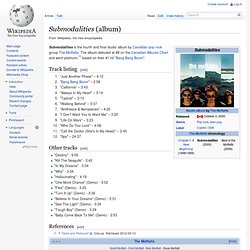
The album debuted at #8 on the Canadian Albums Chart and went platinum,[1] based on their #1 hit "Bang Bang Boom". NLP Submodalities. NLP Articles Articles The Importance of Doing what’s Important in Life by Jevon Dängeli What do you really want in life?
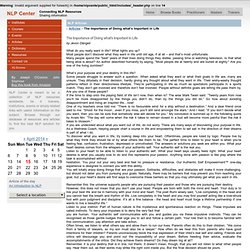
What lights you up? What’s your purpose and your destiny in this life? Remember this: the universe supports people who are pursuing their passion and those who are pursuing their destiny. Written by Jevon Dängeli – NLP / HNLP Trainer & Wellness Coach IQ Scores NLP Center is meant to be a collection of NLP resources worldwide, be it trainers, institutions, events or simply related links with useful information on the subject. NLP Article. Use NLP submodalities to change the way you feel about anything. And change the way you feel at any time & in any situation.

Use NLP submodalities to thwart fear, raise confidence and blaze passion anytime, anywhere. The brain uses submodalities as a medium to represent feelings. Our experience of the world is acquired through the data gathered by our five senses (sight, sound, taste, smell and touch) and the interpretations of the data by our brains. However, that is not all there is to it. Our interpretations of the data are also affected by submodalities. Submodalities Model, Part 1 at Connecting With NLP. Submodalities are one of the predominant models in NLP.
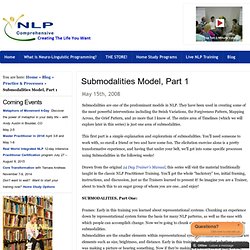
They have been used in creating some of the most powerful interventions including the Swish Variations, the Forgiveness Pattern, Mapping Across, the Grief Pattern, and 20 more that I know of. The entire area of Timelines (which we will explore later in this series) is just one area of submodalities. This first part is a simple explanation and exploratioin of submodalities. You’ll need someone to work with, so enroll a friend or two and have some fun. The elicitation exercise alone is a pretty transformative experience, and having that under your belt, we’ll get into some specific processes using Submodalities in the following weeks!
Drawn from the original 24 Day Trainer’s Manual, this series will visit the material traditionally taught in the classic NLP Practitioner Training. Submodalities Model, Part 2: Mapping Across at Connecting With NLP. Following on your proactive practice with last week’s introduction and preparation, you’ll be able to step right in to this fundamental and powerful piece of NLP.
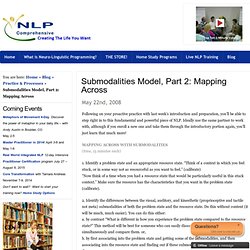
Ideally use the same partner to work with, although if you enroll a new one and take them through the introductory portion again, you’ll just learn that much more! MAPPING ACROSS WITH SUBMODALITIES (trios, 15 minutes each) 1. Identify a problem state and an appropriate resource state. “Think of a context in which you feel stuck, or in some way not as resourceful as you want to feel.” 2. 3. 4. 5. Go over each exercise step briefly after the demonstration.
Discussion: What generalizations can you make about the difference between problem state submodalities and resource state submodalities in your group? A: We won’t have time to deal with that in detail in this training. Drawn from the original 24 Day Trainer’s Manual, this series visits the material traditionally taught in the classic NLP Practitioner Training. NLP Definitions: Submodalities » Learn NLP - World Of NLP. It’s not always easy to explain submodalities to someone new to NLP.
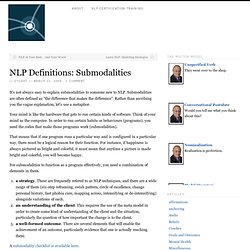
Submodalities are often defined as “the difference that makes the difference”. Rather than ascribing you the vague explanation, let’s use a metaphor. Your mind is like the hardware that gets to run certain kinds of software. Think of your mind as the computer. In order to run certain habits or behaviours (programs), you need the codes that make those programs work (submodalities). That means that if one program runs a particular way and is configured in a particular way, there must be a logical reason for their function. For submodalities to function as a program effectively, you need a combination of elements in them. a strategy.
A submodality checklist is available here.